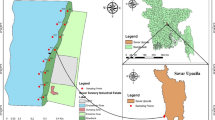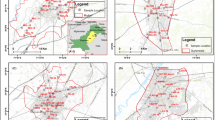Abstract
The present study deals with the assessment of health risks due to fluoride contamination in Bichpuri block of Agra, India. Sampling was carried out from 60 different spatially distributed well locations. Assessment of human health risk was carried out using computations based on chronic daily intake (CDI) and hazard quotient (HQ) in all three categories, i.e., infants, children, and adults. Fluoride ingested by adults, as estimated in terms of CDI was found 1.5 times greater than infants and 1.25 times than children, correspondingly indicating severity of health issue. Moreover, values of HQ were found greater than 1 in the entire target group having infants, children, and adults with the exception only in Bichpuri village of the block. More than 92% of the samples showed risk values exceeding the safe level of 1, indicating vulnerable quality of water due to fluoride. Piper and Schoeller diagram were also plotted to explore presence of other important ions present in the groundwater of studied area.






Similar content being viewed by others
References
Adimalla N, Li P, Qian H (2018a) Evaluation of groundwater contamination for fluoride and nitrate in semi-arid region of Nirmal Province, South India: a special emphasis on human health risk assessment (HHRA). Hum Eco Risk Assess: An Int J 25(5):1107–1124
Adimalla N, Vasa SK, Li P (2018b) Evaluation of groundwater quality, Peddavagu in Central Telangana (PCT), South India: an insight of controlling factors of fluoride enrichment. Mod Ear Syst Env 4(2):841–852
Aldrees AM, Al-Manea SM (2010) Fluoride content of bottled drinking waters available in Riyadh, Saudi Arabia. Saudi Dent J 22(4):189–193
Ali S, Kumari M, Gupta SK, Sinha A, Mishra BK (2017) Investigation and mapping of fluoride-endemic areas and associated health risk—a case study of Agra, Uttar Pradesh, India. Hum Eco Risk Assess: An Int J 23(3):590–604
Ali S, Khan SU, Gupta SK et al (2021) Health risk assessment due to fluoride exposure from groundwater in rural areas of Agra, India: Monte Carlo simulation. Int J Environ Sci Technol https://doi.org/10.1007/s13762-020-03084-2
APHA (2012) Standard methods for the examination of water and wastewaters, 22nd ed. APHA, Assessment, EPA/600/Z-92/001, Risk Assessment Forum. Washington, DC. AWWA, WEF, Washington, DC.
Ayoob S, Gupta AK, Bhat VT (2008) A conceptual overview on sustainable technologies for the defluoridation of drinking water. Crit Rev Env Sci Tech 38(6):401–470
Biglari H, Chavoshani A, Javan N, Hossein Mahvi A (2016) Geochemical study of groundwater conditions with special emphasis on fluoride concentration, Iran. DesalWat Treat 57(47):22392–22399
Chae GT, Yun ST, Mayer B, Kim KH, Kim SY, Kwon JS, Kim K, Koh YK (2007) Fluorine geochemistry in bedrock groundwater of South Korea. Sci Tot Environ 385(1–3):272–283
Dutta V, Fatima N, Kumar N (2019) Excessive fluoride in groundwater of Central Ganga Alluvial Plain: a case study of Fatehpur, North India. Int J Env Sci Tech 16(12):7791–7798
Gopalakrishnan S, Mebrahtom K (2006) Prevalence of fluorosis in certain villages of Ghindae area of Eritrea, North East Africa-suggestions for prevention and control. Ind J Env Prot 26(3):202
Guo Q, Wang Y, Ma T, Ma R (2007) Geochemical processes controlling the elevated fluoride concentrations in groundwaters of the Taiyuan Basin, Northern China. J GeochExp 93(1):1–12
Handa BK (1975) Geochemistry and genesis of Fluoride-Containing ground waters in India. Groundwater 13(3):275–281
Integrated Risk Information System (IRIS 2007) US Environmental Protection Agency.
Khan SU, Noor A, Farooqi IH (2015) GIS application for groundwater management and quality mapping in rural areas of District Agra, India. Int J Water Res Arid Env 4(1):89–96
Khan SU, Asif M, Alam F, Khan NA, Farooqi IH (2020a) Optimizing fluoride removal and energy consumption in a batch reactor using electrocoagulation: a smart treatment technology. Smart cities—opportunities and challenges. Springer, Singapore, pp 767–778
Khan SU, Farooqi IH, Usman M, Basheer F (2020b) Energy efficient rapid removal of arsenic in an electrocoagulation reactor with hybrid Fe/Al electrodes: process optimization using CCD and kinetic modeling. Water 12(10):2876
Kotecha PV, Patel SV, Bhalani KD, Shah D, Shah VS, Mehta KG (2012) Prevalence of dental fluorosis and dental caries in association with high levels of drinking water fluoride content in a district of Gujarat, India. Ind J Med Res 135(6):873–877
Kumar PS (2017) Geostatistical modeling of fluoride enrichment and nitrate contamination in the groundwater of Lower Bhavani Basin in Tamil Nadu, India. Mod Ear Syst Environ 3(1):1
Mateen QS, Khan SU, Islam DT, Khan NA, Farooqi IH (2020) Copper (II) removal in a column reactor using electrocoagulation: Parametric optimization by response surface methodology using central composite design. Wat Environ Res 92:1350–1362
Mirzabeygi M, Yousefi N, Abbasnia A, Youzi H, Alikhani M, Mahvi AH (2017) Evaluation of groundwater quality and assessment of scaling potential and corrosiveness of water supply networks, Iran. J Wat Sup: Res Tech Aqua 66(6): 416–425
Mumtaz N, Pandey G, Labhasetwar PK (2015) Global fluoride occurrence, available technologies for fluoride removal and electrolytic defluoridation: a review. Crit Rev Env Sci Tech (just-accepted).
National Research Council (NRC 2001) National Academics Press. Washington, DC.
Pazand K (2016) Geochemistry and multivariate statistical analysis for fluoride occurrence in groundwater in the Kuhbanan basin, Central Iran. Mod Ear Syst Environ 2(2):72
Radfard M et al (2018) Drinking water quality and arsenic health risk assessment in Sistan and Baluchestan, Southeastern Province, Iran. Hum Eco Risk Assess An Int J.
Saravanan K, Srinivasamoorthy K, Gopinath S, Prakash R, Suma CS, Vinnarasi J, Ponnumani G (2018) Geochemical evolution of groundwater along flow path in Upper Vellar sub basin, Tamilnadu, India: an integrated approach using hydrochemistry, modeling and statistical techniques. Mod Ear SystEnv 4(2):647–58
United States Environment Protection Agency (USEPA). 1992. Guidelines for Exposure.
Viswanathan G, Jaswanth A, Gopalakrishnan S (2009a) Mapping of fluoride endemic areas and assessment of fluoride exposure. Sci Tot Environ 407(5):1579–1587
Viswanathan G, Jaswanth A, Gopalakrishnan S, Aditya G (2009b) Determining the optimal fluoride concentration in drinking water for fluoride endemic regions in South India. Sci Tot Environ 407(20):5298–5307
Wagh VM, Panaskar DB, Mukate SV, Gaikwad SK, Muley AA, Varade AM (2018) Health risk assessment of heavy metal contamination in groundwater of Kadava River Basin, Nashik India. Mod Ear SystEnv 4(3):969–980
WHO G (2011) Guidelines for drinking-water quality. World Health Organ 216:303–304
Yadav KK, Gupta N, Kumar V, Choudhary P, Khan SA (2018) GIS-based evaluation of groundwater geochemistry and statistical determination of the fate of contaminants in shallow aquifers from different functional areas of Agra city, India: levels and spatial distributions. RSC Adv 8(29):15876–15889
Author information
Authors and Affiliations
Corresponding author
Additional information
Publisher's Note
Springer Nature remains neutral with regard to jurisdictional claims in published maps and institutional affiliations.
Rights and permissions
About this article
Cite this article
Ali, S., Gupta, S.K., Sinha, A. et al. Health risk assessment due to fluoride contamination in groundwater of Bichpuri, Agra, India: a case study. Model. Earth Syst. Environ. 8, 299–307 (2022). https://doi.org/10.1007/s40808-021-01105-8
Received:
Accepted:
Published:
Issue Date:
DOI: https://doi.org/10.1007/s40808-021-01105-8




